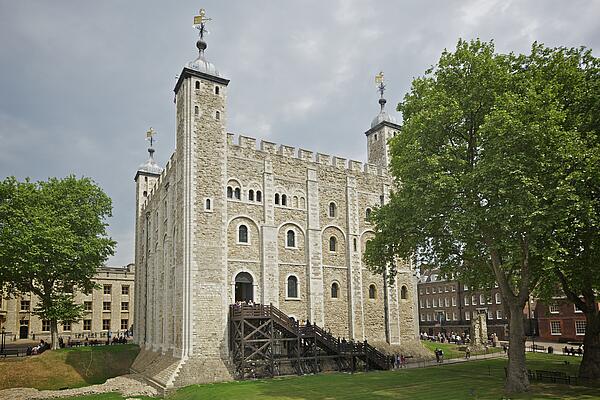Stone Keep Castles
Stone keep castles were first built during the reign of William I as a natural extension to the more traditional motte and bailey castles. The main difference between the two was that motte and bailey castles were designed to be temporary (although lots survive to this day) while stone keep castles were designed to last as long as possible.
Following rebellion in the north of England, and the subsequent “Harrying of the North” in response, William the Conqueror decided to build stone keep castles as the ultimate display of his power. The most famous of these castles was the White Tower at the Tower of London and Rochester Castle in Kent.
By using stone, William was able to construct the castles in a way that was entirely different from motte and bailey castles; while motte and bailey castles were built from wood, the strength of stone allowed for a taller building in stone keep castles.
This new height means stone keep castles had the significant advantage of visibility - allowing the castle to be seen by potential rebels and allowing the castle’s defenders to spot enemies at a distance. Rochester Castle, for example, has views across the Medway estuary, making it easy to spot any enemies attempting to attack from the river.

Stone keep castles also had other benefits, particularly when it came to its defences. Motte and bailey castles were renowned for being easy to set on fire, making it difficult to defend them against armies aware of this weakness. However, it was significantly harder to do the same with a stone keep castle, which had stone walls instead of wood. They also had their main door on the first floor, reached by wooden steps, which meant that the steps could be knocked down to block off the entrance should an enemy appear.
The White Tower, the most famous stone keep, was built by William to defend his supply ships as they travelled up the River Thames. Around 90 feet tall, the building was the highest in London at the time of its construction, making it an intimidating sight to anyone considering an attack on the king’s ships. The interior of the building was also intimidating, with walls that were 15 feet thick at the base and 11 feet thick on the upper storey.
The quality of its construction made the White Tower incredibly strong, and it was never taken during battle. The only time the keep fell into the hands of the enemy was during the Peasants' Revolt, when guards decided to let the rebels inside. Considering the weapons that were available during medieval times, it’s hard to conceive of a situation where the tower could have been taken by force.
The construction of the White Tower was largely completed with stone from Caen in northern France, which was a creamy colour and led to the tower’s nickname. This was brought to England due to William’s ‘distrust’ of Saxon stone. The king also chose to use skilled workmen and architects that he could trust, only allowing the English to complete the heavy unskilled jobs. Despite already being white in appearance, the tower was later whitewashed by Heavy III in 1241, which cemented its label.
Being such a crucial part of the Norman defence, the White Tower was filled with everything required to ensure it was as self-sufficient as possible. This included fresh water, dormitories, royal chambers, a chapel, toilets and kitchens.
The only stone keep castle that is commonly considered to be more impressive than the White Tower is Rochester Castle, which stands at 113 feet tall. This makes it the tallest stone keep castle in England. The walls of this castle are between 11 and 13 feet thick. The castle was constructed by the same architect as the White Tower, Gundulf, who built it along the same geographic lines as a Roman Fort that had been built in the city. It was originally given to the Archbishop of Canterbury.
Square keep castles were incredibly expensive, reaching costs of £3,000 in the cast of Rochester and £4,000 in the cast of the castle at Dover. This was around a third of the king’s annual income of £10,000 each year, making them a significant build.
See also:
The End of Castles
MLA Citation/Reference
"Stone Keep Castles". HistoryLearning.com. 2024. Web.
